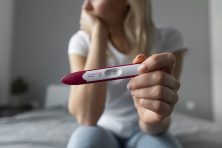IVF Over 40: Fertility and Getting Pregnant at 40

Turning 40 doesn’t mean letting go of the dream of parenthood. Thanks to advances in reproductive medicine—particularly In Vitro Fertilisation (IVF)—many women in their 40s continue to find success in starting or expanding their families. While fertility does decline with age, understanding how IVF works, what steps are involved, and how to optimise your chances can make a meaningful difference in your journey.
What Is IVF and How Does It Work?
In IVF, a woman’s egg is collected from her ovaries and combined with sperm in a laboratory setting. Once fertilisation occurs, the resulting embryo is transferred back into the womb to develop. This process can use the woman’s own eggs and her partner’s sperm or donor eggs and sperm, depending on individual needs and circumstances.
What Happens During IVF: Step-by-Step Overview
Below is a general overview of the IVF process. Treatment protocols can vary depending on individual circumstances, so it is always advisable to follow the guidance of a qualified fertility specialist.
1. Day 1 of Your Menstrual Cycle
The first day of your period typically marks the official start of an IVF treatment cycle. A healthcare provider can help clarify which day counts as Day 1, since cycles can differ from person to person.
2. Ovarian Stimulation
During a natural cycle, the body usually matures a single egg per month. In an IVF cycle, hormonal medications (often containing follicle-stimulating hormone, FSH, and luteinizing hormone, LH) are administered for about eight to fourteen days. This encourages multiple follicles in the ovaries to develop simultaneously, thereby potentially producing more than one mature egg.
- Medication Form: Commonly given as injections.
- Monitoring: Blood tests and ultrasounds—often transvaginal—are performed to track follicle growth and adjust medication if needed.
When the follicles reach a suitable stage, a ‘trigger injection’ is given to finalize egg maturation. The timing of this injection is crucial so that egg retrieval can occur before ovulation.
3. Egg Retrieval
Egg retrieval is typically a day procedure performed under mild sedation or general anesthesia. Using ultrasound guidance, a specialist gently passes a needle into each ovary to collect fluid from mature follicles.
- Duration: Usually around 20–30 minutes.
- Recovery: Most individuals can go home a few hours afterward, but it is best to have someone else drive due to the sedative effects.
- Expected Yield: On average, between eight and fifteen eggs may be retrieved, though age and clinical factors can influence this number.
4. Sperm Preparation
If fresh sperm is used, a sample is usually provided on the morning of egg retrieval. If donor or frozen sperm is involved, the laboratory staff will prepare it in advance. The sample is assessed under a microscope to select the healthiest sperm with the most favorable morphology (shape) and motility (movement) for fertilization.
5. Fertilisation
In the laboratory, the retrieved eggs are combined with the prepared sperm. This can be done through:
- Standard IVF: Eggs and sperm are placed together in a culture dish to fertilise naturally.
- ICSI (Intracytoplasmic Sperm Injection): A single sperm is injected directly into each mature egg.
Fertilisation is usually assessed the next day (around 17 hours later) by checking for the presence of pronuclei—genetic markers indicating successful fertilization.
6. Embryo Development
Fertilised eggs begin to develop into embryos, which are cultured in conditions designed to mimic the natural environment of the female reproductive tract. Progress is monitored over the following days:
- Day 2: Typically, embryos should have two to four cells.
- Day 3: Embryos often reach six to eight cells.
- Days 5–6: Embryos may develop into blastocysts, containing around 100 cells.
Not all eggs will fertilise or reach the blastocyst stage. Factors such as egg quality, sperm quality, and genetic viability can influence development.
7. Embryo Transfer
If an embryo reaches a suitable stage of development, it can be transferred to the uterus. This procedure usually does not require anesthesia and resembles a Pap smear. A thin catheter containing the embryo is passed through the cervix and into the uterine cavity. Many individuals resume normal activities the same day.
8. Pregnancy Test
Around two weeks after the embryo transfer, a blood test measuring human chorionic gonadotropin (hCG) is performed to determine if pregnancy has been achieved. The timing of this test may vary slightly based on the specific treatment plan and how the body responds post-transfer.
If you want a more detailed overview over the IVF process, you can read more here.
Fertility Challenges and Ovarian Reserve
Ovarian reserve refers to the total number and quality of eggs remaining in the ovaries. This reserve plays a key role in fertility, as it directly impacts a woman’s ability to conceive—either naturally or through treatments like IVF. When ovarian reserve is lower, the chances of producing healthy eggs decrease, which can lead to fewer fertilised embryos and a higher risk of pregnancy complications. Women over 40 typically experience a marked decline in ovarian reserve, making it crucial to understand how this factor influences their fertility options.
Why Does Fertility Decline for Women Over 40?
As women move into their late 30s and early 40s, the quantity and quality of available eggs begin to drop at an accelerated rate. This natural decline in ovarian function means fewer healthy eggs are available for fertilisation each cycle. In addition, eggs are more prone to chromosomal abnormalities over time, which can lead to a higher likelihood of miscarriage or pregnancy complications. While each person’s reproductive health is unique, these age-related factors often make conceiving over 40 more challenging, whether through natural means or IVF.
How to Assess Your Ovarian Reserve
Several tests help evaluate ovarian reserve and guide fertility planning for women over 40:
- AMH (Anti-Müllerian Hormone) Test: Measures the level of AMH in the blood, providing an estimate of remaining egg supply.
- Antral Follicle Count (AFC): Uses ultrasound to count the small follicles in the ovaries at the start of a cycle; a low count can suggest reduced egg availability.
- FSH and Estradiol Levels: Higher follicle-stimulating hormone (FSH) levels, especially early in the cycle, may indicate that the body is struggling to recruit healthy eggs, pointing to a lower ovarian reserve.
By combining these assessments, healthcare providers can customise IVF or other fertility strategies to improve the likelihood of a successful pregnancy for women over 40.
Chances of Success: IVF Over 40
Below you’ll find an overview over the success rates for IVF treatments for women aged 40 and above:
| Age | First Cycle | Second Cycle | Third Cycle |
| 40-41 | 13% | 21% | 25% |
| 42-43 | 6% | 10% | 11% |
| 44+ | 2% | 5% | 5% |
While these numbers do not seem encouraging, there are certain things you can do to enhance your chances of parenthood, even at a later stage in life.
- Weight: Both obesity and being underweight can disrupt ovulation and lower sperm quality. As such, maintaining a healthy weight is important for women trying to conceive.
- Smoking: While it is widely known that smoking is unhealthy, it is important to note that it damages eggs, fallopian tubes, and sperm. Therefore, when trying to become parents, both partners should refrain from smoking.
- Alcohol & Substances: Excessive use may impair fertility and/or sperm health.
Preparing to Undergo IVF After 40
Embarking on IVF in your 40s involves more than just scheduling treatments; it requires a comprehensive approach to health and fertility. It’s advisable to undergo a thorough medical evaluation to assess ovarian reserve (often via AMH testing, antral follicle count, and FSH levels) and identify any underlying issues that may impact your IVF journey. Making lifestyle adjustments—such as adopting a balanced diet, maintaining a healthy body weight, and reducing or eliminating smoking and excessive alcohol—can also help optimize fertility outcomes.
Key Steps Before Starting Your IVF Cycle
- Consult with a Fertility Specialist: Discuss your medical history, explore treatment protocols tailored to your specific needs, and arrange any recommended diagnostic tests.
- Evaluate Ovarian Reserve: Tests like AMH and ultrasound scans help determine how your ovaries may respond to stimulation.
- Prepare Emotionally and Financially: IVF can be both emotionally and financially demanding, especially since the number of needed cycles increases with age. Proper planning and support (counseling or support groups) can make the process smoother.
- Review Medications and Supplements: In some cases, healthcare professionals may suggest specific supplements or prescribe medication to improve egg quality and support the reproductive cycle.
Moving Forward With IVF Over 40
Despite the challenges that come with age-related fertility decline, many women successfully conceive with IVF in their 40s. Thorough preparation, individualized treatment, and close medical supervision can greatly enhance the odds of a healthy pregnancy. For more guidance on IVF over 40—or to connect with trusted UK-based fertility partners—reach out to Ovoria today and take your next step toward parenthood.
Frequently Asked Questions
How many IVF cycles before success over 40?
Success rates generally decrease with age, so multiple cycles (often two or three) may be required. Some women conceive on their first try, while others may need several attempts or consider options like donor eggs.
How to improve egg quality for IVF over 40?
Maintaining a healthy weight, avoiding smoking and excessive alcohol, managing stress, and taking recommended supplements (e.g., antioxidants, CoQ10) can support better egg health. Always consult with a fertility specialist for personalized guidance.
How many rounds of IVF is normal over 40?
It varies by individual, but many women over 40 need two or more IVF cycles due to lower ovarian reserve and reduced egg quality. A fertility specialist can assess your situation and help determine the most suitable number of attempts.
References
Hourvitz, A., Machtinger, R., Maman, E., Baum, M., Dor, J., & Levron, J. (2009). Assisted reproduction in women over 40 years of age: how old is too old?. Reproductive biomedicine online, 19(4), 599-603.
Marcus, S. F., & Brinsden, P. R. (1996). In-vitro fertilization and embryo transfer in women aged 40 years and over. Human Reproduction Update, 2(6), 459-468.
Klipstein, S., Regan, M., Ryley, D. A., Goldman, M. B., Alper, M. M., & Reindollar, R. H. (2005). One last chance for pregnancy: a review of 2,705 in vitro fertilization cycles initiated in women age 40 years and above. Fertility and sterility, 84(2), 435-445.




